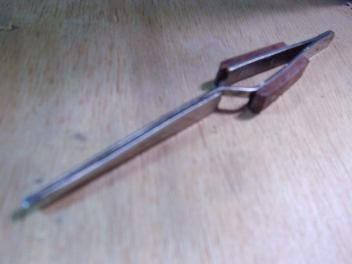
Modelling Tips
Modelling AFV’s really does give tremendous scope to
the modeller for adding interesting effects to the appearance of their models. I
won’t try to cover the established techniques like dry-brushing; they are already
covered at the web sites of some excellent modellers. But I will talk about some
techniques I’ve discovered for myself during the course of making my own models &
dioramas. I may not be the first to figure them out – but I’d like to share them
anyway.
Special Washes
When the second coat of the base colour has been sprayed onto the model, I tend to apply a
dark wash to the model about 30 minutes after its application. This should consist of
white-spirit, a mix of brown enamel paint and, if you have it, some dark brown artists
chalk pastel. What this does is give a great dirty weathering affect to the base
colour. Caution should be exercised however, if the second base coat is too wet, it will
run into the wash and give undesirable effects. Also be sure that the wash does not
collect in pools, because the white spirit will start to melt the base coat. Most modeler
feel anything like this should be avoided - but when the surface of the base coat will
starts to crack and disrupt in places, it can be extremely effective. Its a fine line
between achieving an intersting effect and ruining your paint job. Try it out first on a
discarded model. (see below)

Reducing thickness of plastic
An alternative to plaster for diorama bases
If you want an alternative to plaster, try something called Sculptamold by Amaco.
Its made in the US, but can be bought here in Europe (Art supply shops mainly). I haven't
used plaster so I can't offer a direct comparison. But this stuff has always given very
good results. It mixes with water to produce a mush-like paste that can be moulded
into any shape you wish. It dries plaster hard (place in an oven to speed up dry time
significantly). The benefit of this stuff is that with a little shaping it can produce a
very realistic terrain-like finish.
Equipment
If you find it difficult to paint fine detail on 1/35th scale figures, consider investing
in a combined lamp/magnifying glass. These are a great aid for painting facial details and
other small areas. This magnifies your work area x 2. So you need a really small brush 00
size or less. It takes a while to adjust your brush action & angle when working under
magnification, but once mastered it makes life much easier.
It may go without saying, but a good tweezers is essential. I'd highly recommend the
self-locking type (see below) - this tool was absolutely essential working on the wooden
ship - but its equally handy for ordinary kits. Less likely to drop small parts, and it
also allows you to position the part at awkward angles.

If you have a heat-sink from an old microprocessor, try placing it on the body of your air-compressor. It really does help draw the heat from the unit housing. This allows you to run the compressor a little bit longer than normal & for it to cool down quicker. However, this DOES NOT mean that you can overrun it too much. Not only is it dangerous, it would probably shorten the life of your compressor.
